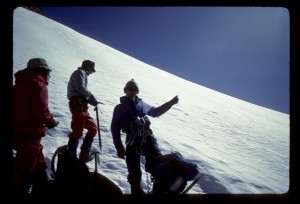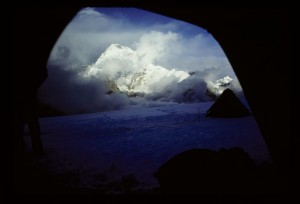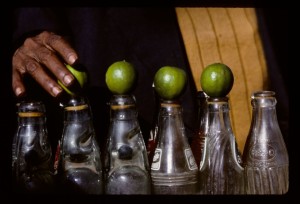Erik Satie: Sarabande No. 3, 1887.
Listen to the full track
Listen to the author reading the text
 Satie was essentially a Dadaist, who believed that the world meant nothing at all, that there were no lessons to be learned from rocks, and who thus set about his own didactic campaign of informing the world of this in witty pieces which quote from other composers, turn familiar music upside down, go on endlessly, often giving sassy, poetic, and nonsensical instructions to the player, thus creating a sort of music which exists in between the road directions and the road, interstices which can never be heard and which can only exist in a performer’s or listener’s mind, thus creating a kind of “program music,” that is, music with a hidden agenda or story, which may have motivated the composer and which can serve to enlighten the performer and inform the listener.
Satie was essentially a Dadaist, who believed that the world meant nothing at all, that there were no lessons to be learned from rocks, and who thus set about his own didactic campaign of informing the world of this in witty pieces which quote from other composers, turn familiar music upside down, go on endlessly, often giving sassy, poetic, and nonsensical instructions to the player, thus creating a sort of music which exists in between the road directions and the road, interstices which can never be heard and which can only exist in a performer’s or listener’s mind, thus creating a kind of “program music,” that is, music with a hidden agenda or story, which may have motivated the composer and which can serve to enlighten the performer and inform the listener.
The psychological reality of program music is that such forcible imaginings distract the pianist long enough to let the unconscious instincts convey something more truthful than any planned playing might. So stories distract us to let other stories past.
A Sarabande was a Baroque dance often included by Bach in his Suites, but here must be thought of as a midsummer reverie, a dreamy freeform fantasy, something danced by Miranda on her magic island in The Tempest or Olivia in Twelfth Night, or Rosaline in Love’s Labour’s Lost, or Bassanio in The Merchant of Venice, where suburban Belmont is a land of strange music, those enchanted Shakespearian summer gardens where time stops and, with it, rhythm. One of the requirements of timelessness is that it have no beat, but be suspended breathlessly above the pulsing clock of night and day in its own world, the way we hold our breath underwater and hear only the beat of our own blood. That slow throb nevertheless gives a clue of what such soporific trances take for tempi, and playing this piece too fast loses its contemplative feeling.
A hesitant chord begins it, then silence. Then a falling theme, repeated twice more with different notes, getting more insistent. I am reminded of the Lobster-Quadrille in Alice’s Adventures in Wonderland:
“Will you walk a little faster?” said a whiting to a snail,
“There’s a porpoise close behind us, and he’s treading on
my tail.
See how eagerly the lobsters and the turtles all advance!
They are waiting on the shingle—will you come and join
the dance?
Will you, won’t you, will you, won’t you,
will you join the dance?
Will you, won’t you, will you, won’t you,
won’t you join the dance?”
 Static flower-twined chords contribute to the moonlit suspension of time, and the falling notes repeat again, maybe somehow inspired or woken by the chords that call to the dance.
Static flower-twined chords contribute to the moonlit suspension of time, and the falling notes repeat again, maybe somehow inspired or woken by the chords that call to the dance.
The chords repeat again, but this time fading away, as a dreamy Debussy theme leads to the deep bass and loud dramatic clarion calls to action which in turn provoke the initial dreamy chord to sound, this time more emphatically. So some progress has been made towards getting out of bed, or climbing out of Puck’s bower up in the trees.
The same chord sounds again, this time calmer, maybe more sure of itself, a bit wiser, and the whole process repeats, the same notes, but this time new emotional issues inform the notes with more meaning, neurosis, sadness, intangible things which can only be communicated by using the notes as a kind of speech to pronounce thoughts the pianist is having. So reacting to Satie’s notes creates a secondary reaction in the pianist which changes the sound of the following notes, and a vicious circle is created, not so much vicious as viscous. Seemingly shallow, Satie’s waters run deep, and the conversation he is staging between his polite, if bizarre, voices questions the very existence of music. Why climb mountains? Why even ask questions? The answer lies in our need to ask.
Another falling scale, consisting of strange harmonies, so that the world is lit by a bizarre sun, an alien light, a technique used by Russian writers called strangification, wherein familiar things are described as if being seen clinically for the first time by someone unfamiliar with all their usual meanings, so a surreal world is created. The scale this time leads to a discordant bass note, which invokes a more insistent trumpet call to wake, or dance, leading to the same initial, androgynous, ambivalent chord, either a “let’s wait and see” or a polymorphous Orlando-ish sensuality.
 Slightly new chords follow, almost conversational, followed by a run leading to a more resolving note, in a more sympathetic tonality. The conversational chords reply, more sure this time, and another run leads to a different bass note which at last seems in the right key, more resolving, more comforting.
Slightly new chords follow, almost conversational, followed by a run leading to a more resolving note, in a more sympathetic tonality. The conversational chords reply, more sure this time, and another run leads to a different bass note which at last seems in the right key, more resolving, more comforting.
Now the longest conversational chord sentence yet bursts on the scene, followed by a shorter five-chord answer, and a quieter, more definite five-note reaffirmation.
At this stage the piece is half over, and simply repeats, more or less, giving the pianist a chance to deepen his conversation with these spirits, to experience wiser replies, until a resolution is reached and the chords fade away. I must admit I find Satie’s last chord a bland goodbye, so I’ve put in a chord which I consider more in keeping with the piece than Satie’s flat D flat chord, the home key of the piece and an obvious way to end anything. Satie is too outrageous in his tonalities to settle for a normal ending after so much invention. It’s like Hamlet handing out popcorn after he dies. Let the forces of righteousness assemble against me in the meeting halls of Salem. I have my ticket to Rio.
